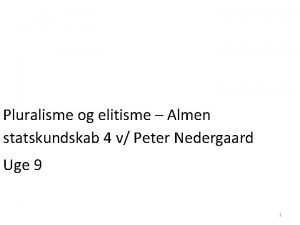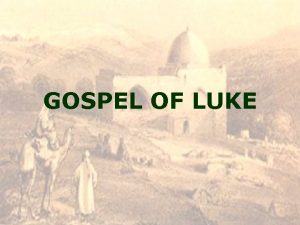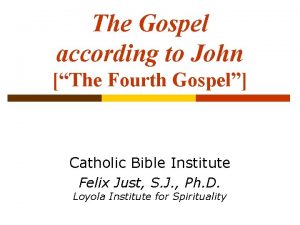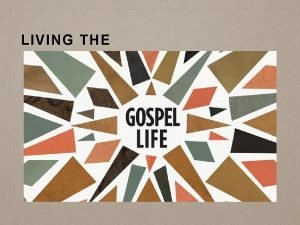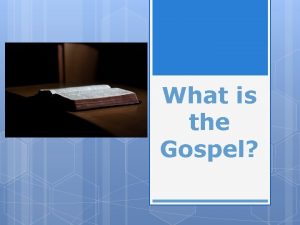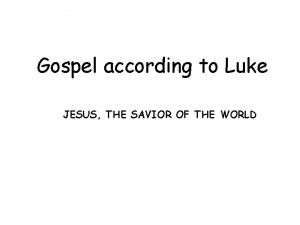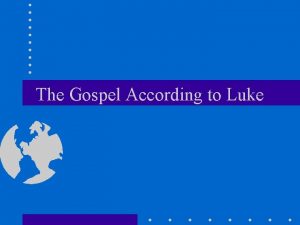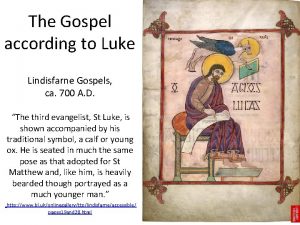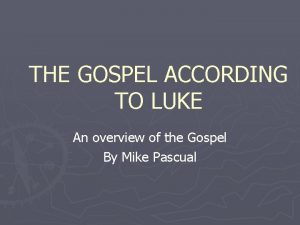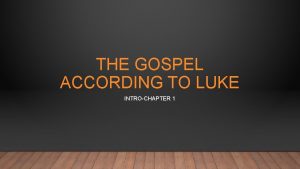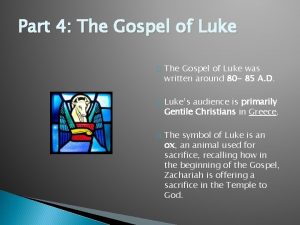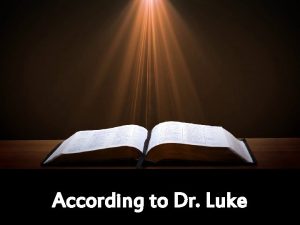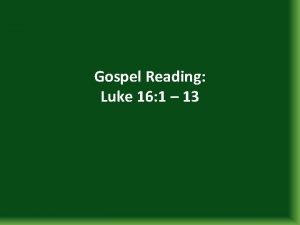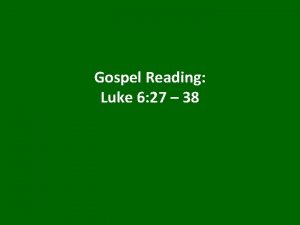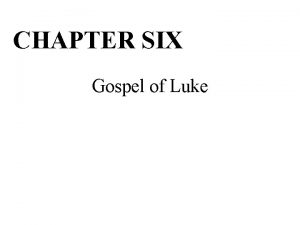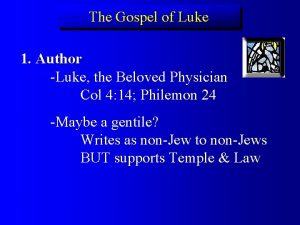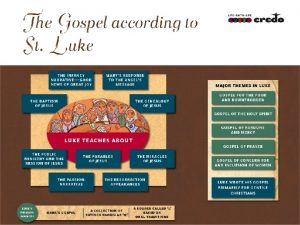LUKE THE GOSPEL ACCORDING TO Foundations of Lukes



























- Slides: 27

LUKE THE GOSPEL ACCORDING TO:

Foundations of Luke’s Gospel • Written between 80 -85 A. D. by a Greekspeaking Christian, who probably lived outside of Palestine. • The longest of the 4 Gospels • Used Mark, “Q” and “L” as his sources

Audience of Luke’s Gospel • Whereas Matthew was oriented primarily toward a Jewish community, Luke is oriented toward the Gentile community (in other words, the WHOLE WORLD). • AUDIENCE: Wealthy Gentile Christians living in an urban setting living in Greece.

Luke’s Concerns • Luke is concerned with explaining how salvation moved from the Jewish people to non-Jews (Gentiles) • He explains this by portraying Jesus as a prophet, very similar to the prophets of the Old Testament. • Recall Matthew’s concerns; how is Luke different?

Basis for Final Judgment in Luke • Parables of the Rich and the Poor (Luke 16: 131) • People are judged on how they use their wealth and possessions. • Leave everything and follow Jesus. • Share with the poor. • Accept everyone, especially outcasts, women and enemies.

Christology of Luke’s Gospel • • • Jesus is a great prophet in word and deed Jesus is the Lord of all nations Jesus is the savior (especially of the poor) Jesus heals the sick and impaired Jesus forgives sinners and debtors

Jesus’ Major Opponents in Luke • Unjust civil and religious authorities • The rich and the corrupt • Very similar to the message of the Hebrew prophets.

Luke’s Birth Narrative in Comparison • By beginning with a birth narrative, Luke is similar to Matthew (recall: there is no birth narrative in Mark). • There are some broad similarities between the two Gospels: • Jesus is born in Bethlehem • Jesus is born to a virgin named Mary • Mary is engaged to a man named Joseph • There also many striking differences between Matthew and Luke.

Jesus’ Birth Narrative in Comparison • Luke: 3 shepherds…Matthew: 3 Magi • Luke: Journey to Bethlehem…Matthew: Flight to Egypt • Luke: Angel speaks to Mary…Matthew: Angel speaks to Joseph

Luke’s Orientation to the Temple • The message of God’s salvation comes first to the Jews. • The offer of God’s salvation is rejected in the city of God (Jerusalem) by the people of God (Jews). • This rejection of God’s salvation leads to salvation being offered elsewhere, namely to the non-Jews (Gentiles).

Luke’s Orientation to the Temple • “Did you not know that I had to be in my Father’s house? ” (Luke 2: 49) • Early on in Luke’s narrative, Jesus is associated with the Temple. • Compare the stories of the temptation in the wilderness… • Matthew 4: 1 -11 • Luke 4: 1 -13 – For Luke, the Temple is the place where Salvation comes and the real “cosmic battle” is waged.

Luke’s Orientation to the Temple • In summary… • For Luke, the message of God comes to his people (the Jews) in their most sacred city (Jerusalem) in the most sacred of all sites (the Temple), but this message is not meant simply for the Jewish people. • For Luke, it is a message of salvation for all people.

Jesus, the Rejected Prophet • Recall Mark: Jesus as an authoritative leader, teacher and healer • Recall Matthew: Jesus as the “New Moses” who bring the authoritative interpretation of God’s Law. • Luke: Jesus as a rejected prophet, cut from the same cloth of the Hebrew prophets in the Old Testament.

Jesus, the Rejected Prophet • Jesus’ sermon in Nazareth (Luke 4: 16 -30) • Jesus is makes it clear that he is a prophet of God, who will NOT receive a warm welcome among his own people in Israel. • Similarly, remember how the Israelites turned away from God and rejected God’s prophets. • Because Jesus’ message is rejected by the Jewish people, it will be taken to the Gentiles.

Jesus as a Prophet in Life • Remember, in ancient Israel, prophets were spokespersons for God; messengers sent by God to his people. • When Jesus begins his public ministry, he claims to be anointed as a prophet who will proclaim God’s message to his people. • Jesus preaches as God’s prophet • Jesus performs miracles as God’s prophet • Compare 1 Kings 17: 17 -24 with Luke 7: 11 -17)

Jesus as a Prophet in Death • The greatest prophets in Jewish history were violently opposed and sometimes even martyred by their own people. • Elijah, Elisha, Jeremiah, Ezekial, Amos • Luke places Jesus in this prophetic line. • Jesus knows that he must die as a prophet (Luke 13: 32 -34) • Compare this with Mark, where Jesus is uncertain about the need for his own death.

Jesus as a Prophet in Death • Jesus’ passion narrative (Luke 22: 39 to 24: 50) • In Luke, Jesus doesn’t appear to be distraught about what is happening to him. • Jesus is more concerned about the fate of others. » The women (Luke 23: 28) » The people responsible for his death (Luke 23: 34) » The criminal (Luke 23: 42) • As a prophet, Jesus knows he must die: – “Father, into your hands I commend my spirit. ” – Compare with Mark: “Why have you forsaken me? ”

Jesus’ Social Message • Like all good prophets, Jesus has a social message. • More than any of the other Gospels, Luke emphasizes Jesus’ concern for the social problems of his day. • Jesus pays special attention to women in Luke’s Gospel. • Encourages women to abandon their traditional roles as caretakers so that they can heed his words as disciples.

Luke: In Summary • Like Mark and Matthew, Luke is a Greco. Roman biography about Jesus. • Luke stresses that salvation was first directed to the heart of Judaism, but Jesus as a Jewish prophet was rejected by his own people. • Jesus’ message was then sent to the whole world, for the salvation of all people. • It was a message of forgiveness of sins to all who would repent.

JOHN THE GOSPEL ACCORDING TO:

Jesus’ “Signs” in John’s Gospel • Jesus’ miracles are signs of his divine identity. Examples include: • • Turning water into wine (2: 1 -11) Feeding the 5, 000 (6: 1 -14) Walking on Water (6: 16 -21) Raising Lazarus from the dead (11: 1 -44) • When Jesus performs healings and miracles, and then debates with the Jewish authorities about its significance. • Miracles are intended to invoke faith on the part of those who witness them, beginning with his disciples.

Jesus’ “Signs” in John’s Gospel • These miracles are testimonies to who Jesus is (John 20: 30 -31). • They are not acts of mercy (Mark and Luke) or signs of God’s kingdom to come (Matthew). • The miracle stories are methods that John uses to convey his message about Jesus.

A Comparative Look at Miracles • Compare the story of Lazarus (John 11: 1 -44) with the synoptic account of Jesus’ raising of Jairus’ daughter (Mark 5: 21 -43) • Significant differences: • In John, Jesus intentionally stays away until Lazarus dies (John 11: 6 & 11: 15) • In Mark, Jesus heals the girl in private; in John, Jesus makes it a public spectacle.

Jesus and the “I Am” Sayings • Jesus speaks about himself far more in John than in the other Gospels. • Jesus uses the verb “I am” 46 times in John’s Gospel (compare with 2 times in Mark and Luke and 5 times in Matthew) • Jesus uses 7 “I am” sayings to speak about himself symbolically. • Jesus sometimes refers to himself as “I AM” (John 13: 19) • Where else have we seen “I am” before?

Christology of John’s Gospel • “High Christology” • “I AM”/Equal to God • Jesus is portrayed as apart from the course of events in the Gospel. • Example: In his death, Jesus shows no pain, and no emotion (cf. Mark 14: 32 -42) • When he dies, Jesus says, “It is finished” which implies that Jesus was in control of the events until the very end. • Read the passion narrative (John 18 -20)

Comparison: Jesus’ Final Words Matthew Mark “My God, my God, why have you forsaken me? ” ----------------- • Low Christology • Jesus’ humanity • Abandonment Luke “Father, into your hands I commend my spirit. ” --------- • Acceptance of what is going to happen. • Jesus realizes that, as a prophet, he must die • Jesus understands that his death on earth is not the end; he will be in paradise. John “It is finished. ” --------- • Emphasizes the control that Jesus has over the entire situation. • Everything happens according to a divine plan.

“I AM” Sayings in John INSTRUCTIONS: Find the following symbolic “I AM” statements in John’s Gospel. On a sheet of paper, answer the following questions for each: 1. What is Jesus saying on a surface level? 2. What is Jesus saying symbolically? 3. Is the symbol appropriate? Why or why not? 1. 2. 3. 4. 5. 6. 7. 8. John 6: 35 John 8: 12 John 10: 7, 9 John 10: 11, 14 John 11: 25 John 14: 6 John 15: 1 John 8: 58* * For the last question, also tell me why this statement is significant given everything that we’ve discussed today.
 Steven lukes makt
Steven lukes makt Ann arbor classification
Ann arbor classification Lukes 3 dimensions of power
Lukes 3 dimensions of power Steven lukes magt
Steven lukes magt Ann arbor lymphome
Ann arbor lymphome ưu thế lai là gì
ưu thế lai là gì Các môn thể thao bắt đầu bằng tiếng nhảy
Các môn thể thao bắt đầu bằng tiếng nhảy Tư thế ngồi viết
Tư thế ngồi viết Hình ảnh bộ gõ cơ thể búng tay
Hình ảnh bộ gõ cơ thể búng tay Cái miệng nó xinh thế chỉ nói điều hay thôi
Cái miệng nó xinh thế chỉ nói điều hay thôi Cách giải mật thư tọa độ
Cách giải mật thư tọa độ Tư thế ngồi viết
Tư thế ngồi viết Ví dụ giọng cùng tên
Ví dụ giọng cùng tên Voi kéo gỗ như thế nào
Voi kéo gỗ như thế nào Thẻ vin
Thẻ vin Thể thơ truyền thống
Thể thơ truyền thống Sự nuôi và dạy con của hươu
Sự nuôi và dạy con của hươu Từ ngữ thể hiện lòng nhân hậu
Từ ngữ thể hiện lòng nhân hậu Thế nào là hệ số cao nhất
Thế nào là hệ số cao nhất Diễn thế sinh thái là
Diễn thế sinh thái là Vẽ hình chiếu vuông góc của vật thể sau
Vẽ hình chiếu vuông góc của vật thể sau Lp html
Lp html Phép trừ bù
Phép trừ bù Lời thề hippocrates
Lời thề hippocrates đại từ thay thế
đại từ thay thế Vẽ hình chiếu đứng bằng cạnh của vật thể
Vẽ hình chiếu đứng bằng cạnh của vật thể Chụp tư thế worms-breton
Chụp tư thế worms-breton Quá trình desamine hóa có thể tạo ra
Quá trình desamine hóa có thể tạo ra



